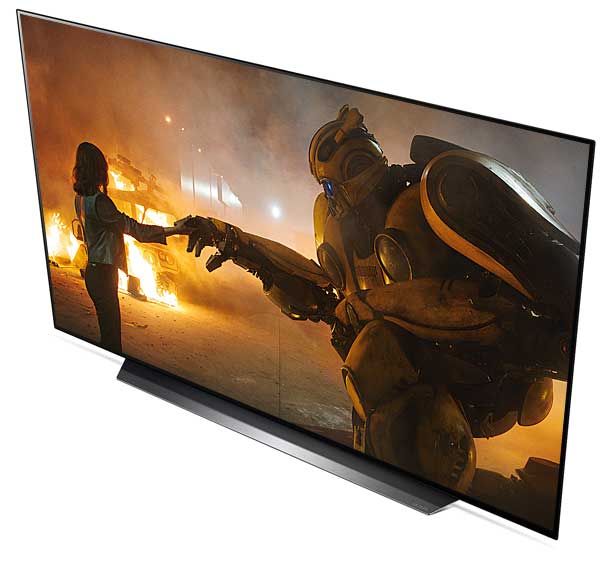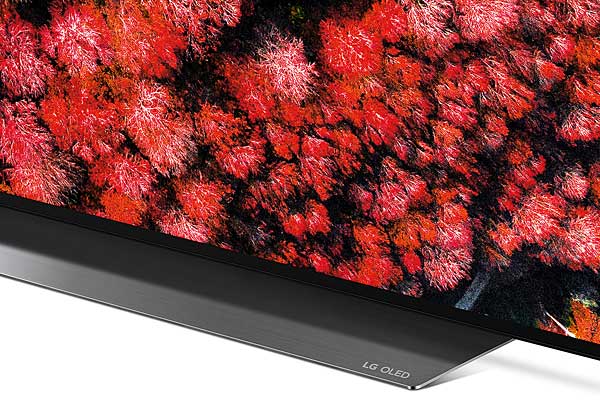LG OLED65C9 OLED 4K HDR TV review Page 2
This OLED TV's images gain brightness and punch when playing HDR. This can be seen in small highlights – such as the stars in 2001: A Space Odyssey or the gleaming metal on show throughout Mad Max: Fury Road (both Ultra HD Blu-ray). But also, even more impressively, it can be seen in the higher average brightness levels achieved throughout typically bright HDR movies.

LG's Dynamic Tone Mapping feature combines with the bolder-looking small peak light areas to help the OLED65C9 produce a deeply satisfying HDR experience that ranks as the best the self-emissive technology has delivered.
It actually produces pretty similar levels of light output on a 10 per cent HDR white window to last year's C8 Series; around 820 nits in Standard mode, and around 740 nits in Cinema mode. But the way the new processing manages the light within that limitation is a big step forward.
The extra brightness of the set's pictures also helps unlock a richer, more dynamic colour performance than I've seen on any LG OLED. ...Fury Road's bright-blue skies appear more natural and subtly nuanced. Reds, too, look less orange, and there's generally more refinement in colour tone delineation. Tones stay consistent across the panel.
Another boost concerns clarity – the OLED65C9's imagery typically looks slightly sharper and more detailed than it has before, with all source resolutions. What's more, LG has combined this detail boost with a reduction in the slight graininess/grittiness previously visible with some titles. It's a clean-looking image.
Even motion – a long-running weakness of LG OLED sets – has been improved. Judder feels less distracting if you're not using LG's TruMotion processing, while there are fewer awkward artefacts if you do give it a spin, at least on its Clear setting.
These major picture improvements are delivered on top of the familiar OLED foundation of fantastic black levels. The OLED65C9 crafts deep, beautifully consistent blacks during dark scenes that are devoid of the greyness, backlight clouds and light haloing issues associated with LCD technology.
Since every OLED pixel makes its own light, moreover, this screen can deliver its brightest white pixel right alongside its darkest, ensuring a ferociously intense sense of contrast, even if the OLED65C9 can't rival the peak brightness levels of premium LCD TVs such as Sony's Z Series or Samsung's QLED lineup.
The TV suffers none of the reduction in contrast, colour saturation or light uniformity during wide angle viewing you get to some extent with any LCD model, either.
Quick As A Flash
This is a TV that therefore sails impressively close to picture perfection at times, but there are also niggles to report. First, LG hasn't fully fixed the 'flashing' issue occurring during moments of very low brightness (transitions around 'near-black' levels), and occasional exaggerated MPEG blocking noise problems, that cropped up on 2018 models. Their impact is reduced; the blocking noise, for instance, seems now pretty much restricted to Amazon Video using the Standard preset. The flashing noise is less aggressive or common, too. Yet it would be great if LG could eliminate these near-black issues entirely.

Bright peaks clip a little in Standard picture mode, too, and the slightly reflective nature of the OLED65C9's screen – together with its relatively limited brightness – make it best suited to dark viewing environments.
Finally, you should always remember to handle OLED TVs with care to stop them falling prey to screen burn, where prolonged exposure to static image elements (such as channel logos) can lead to permanent ghosts of those elements being left behind on the screen. LG provides plenty of tools to help you fight this, including a feature that gently decreases the intensity of static onscreen elements to reduce their potential for harm.
Positives about the OLED65C9 overwhelmingly win the day. This is a flatscreen that can reward you with picture quality that's consistently the stuff of home cinema dreams. It offers dynamism and clarity, colour subtlety and rich, deep blacks. Smart skills are comprehensive, and audio performance surprisingly effective. You can almost hear the gauntlet being thrown down.
HCC Verdict
LG OLED65C9
Price: £3,300
www.lg.com/uk
We say: It looks gorgeous, it sounds great, it's Einstein levels of smart, and its picture quality is consistently fantastic. All of which makes the OLED65C9 great value, too.
Performance: 4.5/5
Features: 5/5
Design: 5/5
Overall: 5/5
Specification
3D: No
4K: Yes. 3,840 x 2,160
HDR: Yes. HDR10; HLG; Dolby Vision Tuner: Yes. Freeview HD; satellite HD
Connections: 4 x HDMI inputs; 3 x USB 2.0 ports; Ethernet; RF input; optical digital audio output; headphone output
Sound (CLAIMED): 60W (40W + 20W subwoofer)
Brightness (CLAIMED): N/A
Contrast ratio (CLAIMED): N/A
Dimensions (off stand): 1,449(w) x 830(h) x 46.9(d)mm
Weight (off stand): 25.2kg
Features: Built-in Wi-Fi; HDMI 2.1; Bluetooth (5.0); Alpha 9 Gen 2 processor;
eARC; auto game mode and VRR support; AI picture and sound modes; Dolby Atmos decoding; Amazon Alexa, Google Home and LG ThinQ voice recognition
 |
Home Cinema Choice #351 is on sale now, featuring: Samsung S95D flagship OLED TV; Ascendo loudspeakers; Pioneer VSA-LX805 AV receiver; UST projector roundup; 2024’s summer movies; Conan 4K; and more
|

















































